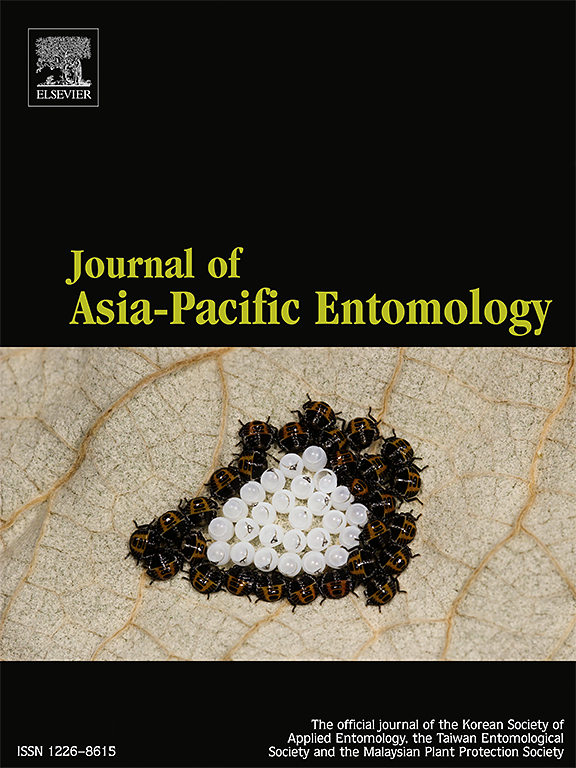Cotton pollen and honey sustain the adult Hippodamia variegata (Goeze) population during periods of prey scarcity
IF 1.3
3区 农林科学
Q3 ENTOMOLOGY
引用次数: 0
Abstract
In the cotton fields of Xinjiang province, China, the cotton aphid, Aphis gossypii Golver, is a significant pest, while Hippodamia variegata (Goeze) is its primary natural enemy. Both species are present during the cotton seedling and budding stages, but as the flowering and boll-formation stage progresses, the aphid population rapidly declines, whereas the adult population of H. variegata often remains high for an extended period. To understand this phenomenon, we investigated the effects of feeding newly emerged H. variegata adults with cotton pollen and honey on their survival rate, lifespan, and reproductive capacity. The study found that pollen consumption in H. variegata adults varied significantly with age and sex, with females generally consuming more pollen than males, particularly at 10, 15, and 20 days of age. The aphid-fed group exhibited the longest lifespan (female 56.0 ± 1.8 d, male 60.1 ± 2.7 d), significantly surpassing those fed with cotton honey, collected from bees, (female 36.1 ± 2.2 d, male 31.7 ± 0.9 d) and pollen (female 12.2 ± 0.4 d, male 9.7 ± 0.8 d). While predation on aphids allowed H. variegata to produce 646.1 ± 14.6 eggs over a 30-d period (starting from the first oviposition), none of the adults fed with cotton pollen or honey laid eggs. Therefore, cotton pollen and honey play a positive role in maintaining the adult population of H. variegata in the field when aphids are absent but cannot support reproduction. Nevertheless, this maintenance effect benefits conservation biological control in cotton fields and effectively controls thrips and other pests at subsequent cotton growing stages.

棉花花粉和蜂蜜在猎物稀缺时期维持着成年斑胸草羚种群的生存
在中国新疆省棉田,棉蚜(Aphis gossypii Golver)是棉田的重要害虫,而斑棉蚜(Hippodamia variegata, Goeze)是其主要天敌。两种蚜虫均在棉花苗期和出芽期存在,但随着开花和成铃期的进展,蚜虫种群数量迅速下降,而棉蚜成虫种群数量往往在较长时间内保持较高水平。为了了解这一现象,我们研究了用棉花花粉和蜂蜜喂养新出现的杂交虫成虫对其存活率、寿命和繁殖能力的影响。研究发现,不同年龄和性别的花蜂成虫花粉消耗差异显著,雌性一般比雄性消耗更多的花粉,特别是在10、15和20日龄时。aphid-fed组表现出最长的寿命(女性56.0±1.8 d,男性60.1±2.7 d),大大超过美联储棉花蜜,收集的蜜蜂,(女性36.1±2.2 d,男性31.7±0.9 d)和花粉(女性12.2±0.4 d,男性9.7±0.8 d)。而捕食蚜虫允许h . variegata生产646.1±14.6鸡蛋在30天内(从第一次产卵),没有一个成年人用棉花花粉或蜂蜜下蛋。因此,棉花花粉和蜂蜜在没有蚜虫但不能支持繁殖的情况下,对维持田间杂交虫成虫种群具有积极作用。然而,这种维持效应有利于棉田保护性生物防治,并能有效防治棉田后续各生育阶段的蓟马等害虫。
本文章由计算机程序翻译,如有差异,请以英文原文为准。
求助全文
约1分钟内获得全文
求助全文
来源期刊

Journal of Asia-pacific Entomology
Agricultural and Biological Sciences-Insect Science
CiteScore
2.70
自引率
6.70%
发文量
152
审稿时长
69 days
期刊介绍:
The journal publishes original research papers, review articles and short communications in the basic and applied area concerning insects, mites or other arthropods and nematodes of economic importance in agriculture, forestry, industry, human and animal health, and natural resource and environment management, and is the official journal of the Korean Society of Applied Entomology and the Taiwan Entomological Society.
 求助内容:
求助内容: 应助结果提醒方式:
应助结果提醒方式:


